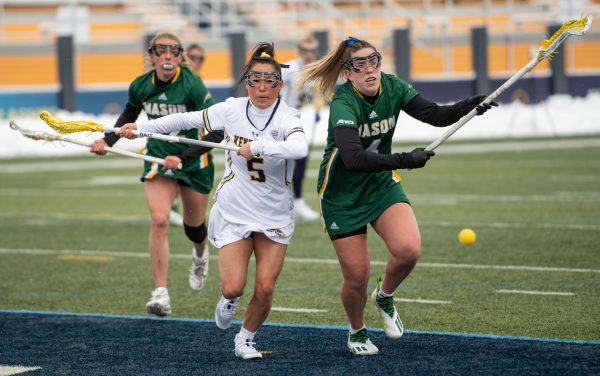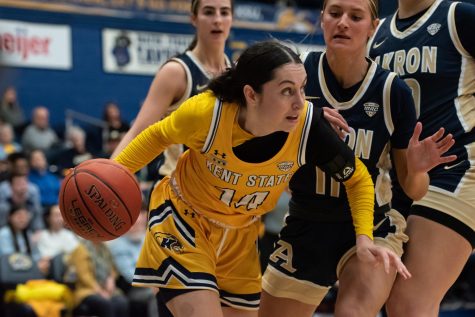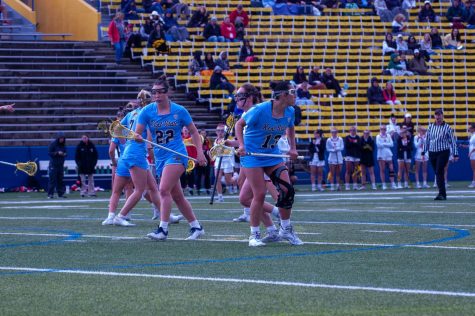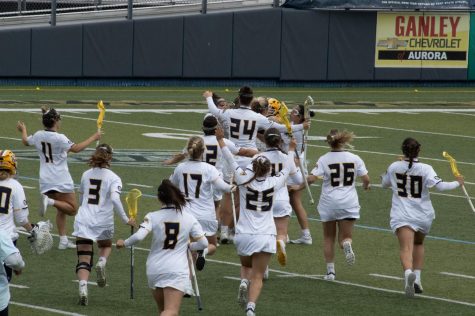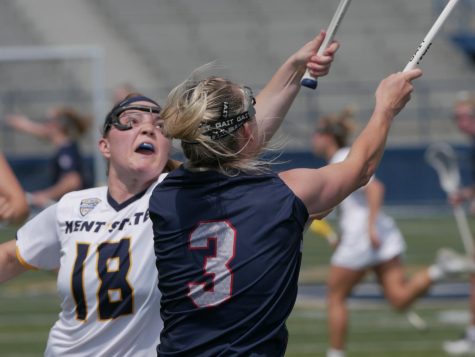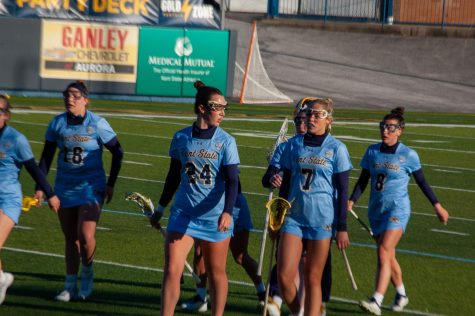Letters to the Editor
February 9, 2007
Don’t take shots at hockey
Dear editor,
Bashing the great sport of hockey is unacceptable. This is a response to Kristine Gill’s Tuesday column. I am a huge hockey fan. Both my brothers have played hockey since they were in kindergarten and over the past 12 years I have learned the rules and discipline that goes into playing the game. So I was quite irked after reading an article that was not only all over the place, but also unfair to the all-American sport.
The columnist went through the various sports where physical contact is not allowed. However, she failed to mention that those sports are either individual competitions (i.e. swimming) or they do tolerate some physical contact. In basketball, players are trying to get the ball away from other players. To do this, players often knock the ball out of another player’s hands or block shots and passes. Plus, there are several sports that involve way more brutal physical contact than other sports, including hockey. What about football or lacrosse? In football people jump on top of each other in a big pile (a.k.a. tackling) and they “sack” players. Instead of sacking or tackling each other, hockey players use checking. There are still regulations against checking from behind and using your stick to trip or hit another player in order to prevent some serious injuries.
The next issue I have is the faking of injuries. If the columnist watched more than one hockey game she would know that if players fake an injury it’s usually to draw a penalty. They don’t just flop on the ice because they made an error. For the most part injuries aren’t faked. I have watched while my brothers, their teammates and opponents have lain on the ice screaming in pain. My brother has broken his collar bone twice and my other brother is a goalie, so he’s been run over a few times in his career. They don’t lie on the ice for sympathy or attention. I’ve watched both big and small guys who are the size of “grown men” be carried off the ice from serious injuries.
Last, but not least, are the celebrations that happen on the ice. How is slapping your stick on the ice and yelling “woohoo!” any less civilized than dancing like a crazy person in the end zone after a touchdown? Also, why doesn’t the columnist mention that sabotage happens in more places than an ice rink? There have been cases of sabotage in almost any sport you could think of. Those cases might not be out there for the world to see but they are definitely there.
Hockey players work hard and they are just as smart and talented as people who play volleyball or run track. They have almost daily practices, lots of physical training and play through various injuries, just like any other athlete. And I don’t know what the columnist meant by saying “Avoid the stench, avoid the sabotaging, and enroll your kids in something like flag carrying.” How is flag carrying better for children? And to those who are flag carriers, does that mean they don’t belong in the world of physical contact sports? The lesson here is to know the subject you’re bashing and to think before making comments like the one above.
Caitlin Goehrig
Sophomore advertising major
Too much stress on cancer
Dear editor,
After reading Jackie Mantey’s Feb. 1 column about the cancer campaign having “too much pink,” I was extremely upset. Being the daughter of someone who is currently fighting through the last stage of brain cancer, I was offended to see all of the emphasis on breast cancer.
Of course it is upsetting to read about the decreasing number of women who are getting mammograms, but breast cancer is definitely not the only cancer that can be detected early. Skin, colon, cervical, rectum, prostate and oral cancers can all be detected at early stages. According to the American Cancer Society, the number of Pap tests given to women over the age of 18 is also slowly decreasing. Why is there no mention of that, no emphasis on these screenings that can be done?
The idea that there is “too much pink” in the cancer campaign is completely absurd, yet true. Perhaps there is not too much pink, but not enough of the other colors. Everywhere you look there is always some sign on breast cancer awareness. Credit cards, clothing, jewelry, ChapStick, yogurt lids, but how many times have you seen a teal tea can for cervical cancer, a white yogurt lid for lung cancer, or purple ChapStick for pancreatic cancer? I even found a pink ribbon on my ATM statement the other day. Why the stress on breast cancer? Are all the other cancers not good enough, not important enough, don’t kill enough people? It seems that might be the case, seeing as how breast cancer is the second most common cancer, but that doesn’t mean that the other forms of cancer aren’t as important and don’t deserve as much recognition.
When someone you love is diagnosed with cancer or any other illness that can end his or her life, you don’t care about how many people have the same illness. What you care about is how many people have died from it, what the chance is that your loved one won’t be there when you graduate from college, get married and have children. What you do care about is the chance that they will make it – what the percentage is they will survive.
The National Cancer Institute released statistics that estimated 214,640 people would be diagnosed with breast cancer in 2006. Out of those people, 41,430 were estimated to die. That may seem like a lot, but it is only 19 percent. NCI also estimated 18,820 people would be diagnosed with brain cancer in 2006, with 12,820 of them dying. That is 68 percent of the people who had brain cancer. To me 68 percent is a whole lot more than 19 percent.
For 2007, NCI estimates that 33 percent of colon/rectum cancer patients, 49 percent of leukemia patients, 32 percent of cervical cancer patients, 75 percent of lung/bronchitis, 60 percent of brain cancer patients and 89 percent of pancreatic cancer patients will not survive. Why are there no donations or proceeds of purchases given to those cancers and research for them? Something has to be done, and I intend on writing to every single company that gives proceeds to breast cancer and ask why they don’t give to other cancer research.
So next time you see a pink ribbon or something, ask yourself why it is not orange for leukemia, or blue for prostate cancer or teal for ovarian cancer.
Mandie Guggenbiller
Junior art history major
Complaining about snow?
Dear editor,
My girlfriend e-mailed me the recent articles about how the administration isn’t canceling classes for inclement weather, and I have to say that I feel really sorry for you guys. I mean, you have to walk to class when it’s cold and snowy outside? Geez, no wonder you’re upset – it sounds like life is pretty rough over there!
2nd Lt. Tony Cox, ’06
82nd Airborne Division
COB Speicher, Iraq
Give the protesters a break
Dear editor,
In a recent “Cheers and Jeers” note, I was disappointed to see that you “jeered” Kent State students for rallying against classes in subzero temperatures.
Now, I’ll admit that when I first heard of the rally I personally thought it was a somewhat silly thing to make a ruckus over and, quite honestly, I was suspicious of some of the students motives (hey, I’d rather sleep than trek through the snow to go to class).
It’s true that there are many more issues in our world that deserve our attention far more than having to go to class in cold weather, but it was wrong of the editorial board to scold these students.
Our generation is considered by many to be one of apathy, especially when it comes to political action (does anybody not know what age group is least likely to vote in every type of election?).
Sure I’d rather see them standing outside their senators’ offices demanding action in Darfur, Sudan, but I commend them, in this age of apathy, for caring about something, organizing and actually trying to do something about it.
Kevin Casimer
Freshman history major
Administration disregarded students’ health
Dear editor,
I would like to pause and thank a group of individuals who take their students’ best interests to heart: Northeast Ohio’s university and college presidents.
These individuals are among the strongest members of our society. Their courageous inaction on Monday was representative of these fine people.
When temperatures hit their lowest point in over a decade, these presidents held strong. When the National Weather Service issued a wind chill warning extending through Tuesday, they laughed in the face of minus 20-degree temperatures. They stayed open while local schools shivered in fear … those pansies.
Thank you, presidents, for understanding that the long walk from our commuter lot would toughen us up for the real world. And I demand the bus stop at the Student Center be closed so it is as cold and exposed as all the others. There’s no sense letting students go soft while they wait 12 minutes for a bus that was supposed to arrive in seven.
Local “meteorologist” Dick Goddard claimed the temperatures in the area were “the lowest in 11 years.”
David Creamer, vice president of administration and the Chuck Norris of higher education, shot back that they “are not that unusual.” Besides, what’s wind chill when you’ve got premium parking?
Presidents, you could have been weak. You could have empathetically told your students you would stay open, canceled morning classes (when the temperature before wind chill hit minus 4 degrees), or, worst-case scenario, you could have taken a genuine interest in your students’ safety and well-being. Just kidding!
So again, I would like to thank these presidents for boldly disregarding the safety of their students. We pay your institutions a lot of money to attend (a little more than last year, actually), and you ensure classes go on in the face of natural dangers.
Finally, remember that your critics are probably pot-smoking hippies who just want a day off rather than to raise legitimate concerns about their health and safety. They may criticize you for your strength Monday, but hold strong, presidents.
Eventually the temperatures will rise – just as your annual salaries do.
Michael Vaughn
senior English major
Where are the other students?
Dear editor,
While only a handful of students attended open interviews with candidates to be their next provost, hundreds signed up for the Facebook group “Kent State! Don’t Put Us in Danger!! Cancel Clases!”
On a campus where students once protested the war in Vietnam, they now march to the president’s office under the banner, “Lefton Unfair! The cold, we can’t bear.”
While the County Clothing Center needs winter coats for the homeless, 40 students meet in Eastway to protest walking across campus in cold weather.
On a campus where students chant, “Frozen feet, frozen nose. School has to close,” I wonder what’s next. Cafeteria walkouts over coffee creamer? A letter-writing campaign about cable TV? A march for valet parking? A Facebook group for those who think the Koonce elevators are too slow?
Where are the students who will object that Kent State has no office for sexual orientation minorities? The lack of state dollars to lower tuition? The racial homogeneity in some departments? Where are the students who will march about the high cost of textbooks and convenience store food? The difficulty of getting an appointment with an academic adviser? Where are the Facebook groups to protest the long-promised and overdue renovation of Oscar Ritchie? University investments in corporations who harm the environment?
Our feet may be cold and our noses frozen. But what of our hearts and minds?
Frank Robinson
Kent
Students right in demanding other food options
Dear editor,
Students should applaud Kent State’s Dining Services director for coordinating a sampling of plant-based food choices (“Students can try free vegan food today,” Monday). Across the country, compassionate and conscientious students are demanding alternatives to factory-farm animal products in their campus cafeterias.
Factory farms are responsible for confining breeding pigs and egg-laying hens in metal cages that are so restrictive the animals can hardly move for their entire lives. Students are right to oppose this industrialized form of animal abuse.
To learn more, visit HumaneEating.com.
Alyson Bodai
Outreach Coordinator for Factory Farming Campaign
Why cheer Texas?
Dear editor,
In a a recent “Cheers and Jeers” note, I was disappointed to see that you applauded Texas for its new vaccination requirements. For starters, Texas had very little to do with that decision. The policy was an executive order of the governor, who by instituting the policy, which obligates the state to dedicate $29 million of its budget to the program, has compromised the democratic process in his state.
Furthermore, the action is far less helpful and altruistic than it appears. The vaccination only applies to four of over 100 strands of human papilloma virus, which in turn are only responsible for a fraction of the different types of cervical cancer, which itself is not considered a “common” (30,000 annual cases) cancer.
While I don’t deny that a handful of young women may potentially benefit from the vaccination – though there is very promising new cancer research that may render it obsolete – it seems rather clear to me who this bill … err, order really helps.
I’ll just put a few facts together:
• Fact 1: The vaccination is made by a company called Merk.
• Fact 2: Gov. Perry’s former Chief-of-Staff is a lobbyist for Merk.
• Fact 3: Perry has received at least $6,000 from Merk for his campaigns.
• Fact 4: A math problem: 365,000 (girls to be vaccinated annually in Texas) x $360 (cost of the vaccine) = $131.4 million dollars Merck stands to gain annually, just
from the Texas vaccination program.
Now, just because Perry may have had personal and political incentives doesn’t mean it’s bad that young girls will be vaccinated is bad. But noting those facts, as well as his disregard for democracy and the possibility that new research on dichloroacetate may very well render this very specific vaccine obsolete, well, I’m not so sure I want to sing his praises.
As for Texas, they had nothing to do with this.
Kevin Casimer
Freshman history major













